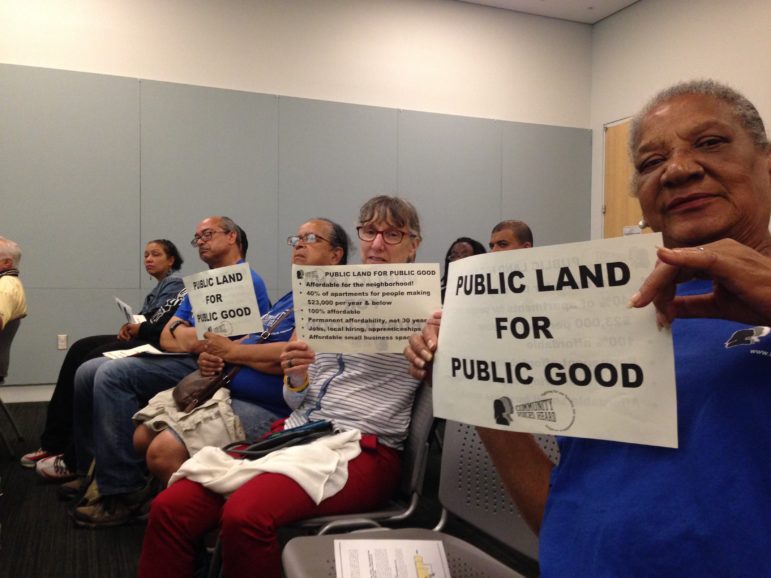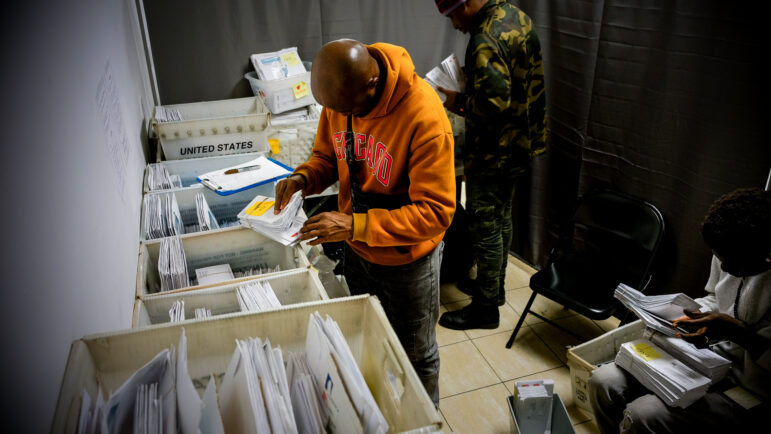
Abigail Savitch-Lew
Questions were raised at this week's scoping hearing.
The MTA is relocating its bus depot at East 126th Street so the city can create a memorial honoring the history of an African burial ground formerly located at the site. At a hearing on Tuesday night, however, some residents of East Harlem expressed worry that the mixed-use development that will go alongside the memorial might overshadow the memorial itself, and that it might not provide apartments or amenities that are affordable to neighborhood residents.
The lot, between 126th and 127th Street and 1st and 2nd Avenues, was the site of a Dutch church and a segregated cemetery in the 1600s. The property was resold in the 1800s, and while white remains were transferred to a Bronx cemetery, the remains of enslaved and free Africans were left behind and desecrated by subsequent development.
In 2009, the Harlem African Burial Ground Task Force, co-chaired by City Council Speaker Melissa Mark-Viverito and a local pastor, began making the case for a memorial to honor the site, and an archeological assessment conducted last year by the Economic Development Corporation (EDC) discovered African remains. A new task force, also lead by the speaker, came up with goals for the site, including the creation of a memorial and cultural center, a mixed-use and mixed-income building that could help to financially support the project, connectivity with the surrounding neighborhood, and job creation.
After consulting with the task forces, EDC released a draft scope of work, a document that outlines the project proposal and discusses what elements of the project will be studied for their potential effects on the environment, leading to a document called an Environmental Impact Statement, or EIS.
In EDC’s plan, a central commercial district with a large residential component will replace the site’s current light manufacturing zoning. EDC will seek to obtain a zoning change through the Uniform Land Use Review Procedure (ULURP).
Officials emphasized that the exact contours and affordability levels of the mixed-use development have yet to be determined. To assess the project’s potential impact on the environment, an assessment will be conducted using a scenario in which the project is built out to the largest scale possible under the proposed rezoning. In that scenario, the project would include 730 apartments, 300 parking spaces in a garage, about 315,000 gross square feet of commercial space, approximately 15,000 gross square feet of community facility space, 15,000 gross square feet dedicated to a cultural and historical center and 18,000 gross square feet of open memorial space. Half of the apartments would be affordable to families making up to 80 percent of area median income ($65,250 for a family of three).
While this scenario does not describe the Request for Proposal (RFP) that will be issued next summer to find a developer, many attendees at the hearing were concerned that the adjacent development could be so large, and with so many market-rate units.
“It fails entirely to present the sacred nature of the site,” said Jean Ballard Terepka, a member of the Harlem African Burial Ground Task Force, at the hearing for the scope of work. She said that the building area outlined in the scope is much larger than the task force’s original vision.
“Affordable housing for whom is a question I have … especially given the violence of gentrification that’s taking place in this neighborhood,” said Erica Jones, a member of Community Board 11. She said she feared that, due to the cost of the apartments, there’d be “white bodies literally living on top of our remains.”
George Janes, a technical consultant for Community Board 11, said that the scope should have included a more specific proposal for the site.
“How big are the buildings going to be? How tall? Where are they going to be on the site?…If you’re expecting comments back on the EIS, it’s a really important piece of information that was left out,” he said.
Attendees also called for the memorial to honor the indigenous people who originally inhabited East Harlem, for the designation of the lot as parkland, and for an analysis of the effects of construction on nearby tenements.
George Sarkissian, representing the speaker’s office, advocated for the dedication of resources to job programs to ensure local hiring, for a maximum number of affordable units and for deep affordability. Athena Moore, representing Manhattan Borough President Gale Brewer, called for 100 percent permanent affordable housing on the site for residents making between 30 and 130 percent AMI, as well as space for performing arts and manufacturing.
EDC will continue to accept comments on the draft scope of work until 5 pm on Friday, October 21, 2016. Comments can be emailed to Denise Pisani at dpisani@cityhall.nyc.gov or sent by mail to the Mayor’s Office of Sustainability Attn: Denise Pisani, Senior Project Manager, 253 Broadway, 14th Floor New York, New York 10007.
City Limits’ coverage of housing and development is supported by the Charles H. Revsion Foundation and the New York Community Trust.









One thought on “Some Question Bid to Combine Burial-Ground Memorial with Mixed-Use Development”
Pingback: News - September 2016 - East Harlem Preservation